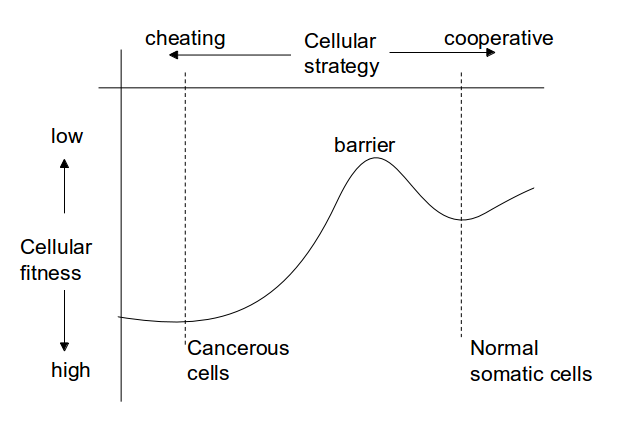博文
My current knowledge/ideas in evolutionary cancer research
|||
It just sounds natural that a bunch of somatic cells in a multi-cellular body can be viewed as a population while evolutionary/ecological theories can be used to look into the population dynamics of these cells, and it sounds tempting that theoretical works my find their application in cancer research and possibly better treatment strategies.
The first conceivable scenario is that we can measure the fitness of each individual (cancerous or peripheral) cell, given its life-history strategy is well defined, and then trace how this fitness may change when the micro-environment is changed due to cancer progression and/or effects of adopted therapy. Once it is understood how to selectively suppress the fitness of the most malignant cells and avoid relapse of evil survivors, better strategies of treatment will be designed accordingly (Robert Gatenby).
Actually people have already gone beyond the above scenario, asking deeper questions, e.g. how cancer have evolved and been avoided in the history of metazoan life forms?
Now it isn't a novel idea that cancer cells are just betrayers in a cooperative multi-cellular body, seeking their own opportunities to maximize offspring cells, rather than contributing to the whole metazoan individual and waiting for itself to be replicated in the next generation of the whole body. Cancer cells can be viewed as an atavistic phenomenon in an evolutionary perspective based on the knowledge that multiple cellular organisms originated from single-cellular organisms. But the tricky question is, how multi-cellular organisms could emerge successfully in the first place?
This refers to the question that how a multiple cellular body win battles against betrayers who always emerge from inside to seek a “free life”. So the question is transformed into a classical economic/ecologic question, where the focus is the maintenance of cooperation in a competitive population or community.
To be cautious, we may not say a “body”, or a population of cells, as one part of the players of this battle. One alternative subject may be the germ-line cells as the monopolist betrayer, in contrast to other cell lineages who all become its slaves (Paul Rainey). Or from the genetic (selfish gene, refer to Richard Dawkins) viewpoint, the genome is the sole bearer of strategies in the battle between its different carriers.
One apparent observation is that multi-cellular organisms like human have never 'evolved' a perfect mechanism to prevent cancer through the whole life span. Logically, they don't have to achieve this goal, as long as it can keep its integrity until successful (or optimal times of) reproduction.
My guess is that both cooperation and betrayal are locally optimal/stable strategies for a cell.

Figure 1. A diagram of cooperation and betrayal as locally stable strategies. A conceptual barrier exists to help prevent betrayers from emerging within a multi-cellular body.
On one hand, it is easy to understand that being cancerous or malignant is locally stable, as they always have more offspring within a time interval than their neighbor competitors. This is the major concern in using population dynamics models to help design better protocols of chemotherapy.
On the other hand, being cooperative should also be a locally stable strategy for any single somatic cells. Its only my guess and I haven't read this from other researchers so far. If being cooperative is not locally stable, then it is hard to imagine how multi-cellular organisms can emerge and thrive in the first place, unless we accept it possible to teach a hen to swim by throwing it into water a million times.
So it is understandable that we can draw a diagram as in Figure 1, where there are two locally stable strategies for a cell and there is a barrier between them, which help multi-cellular bodies maintain their integrity and resist emergence of betrayers to some extent. The message given by the barrier is, "if you are not a really evil betrayer, you'd better be a cooperator." It is noted that here we are considering fitness only at the inter-cellular level, where the fitness at the whole body/population level is not explicitly involved, but implicitly considered.
So one interesting question is if there is indeed such a barrier, and if so, how it is embodied in terms of biochemistry and molecular cellular biology (possibly also in genetics and epigenetics). If we find where this barrier is, then we will know how to utilize this barrier to help reduce the betrayer cells in the patient.
My future work is based on this simple hypothesis, but my scheme framework is a bit more complex, as conflict between mitochondrial and nuclear genomes is also considered in order to comprehensively understand life-history traits of a cell. This was already introduced in an earlier post, and I will keep it updated in future posts.
p.s. Some similarity is seen between game theory models and dynamical systems models, as they are essentially the same thing but with different emphases. Normally game theory works with game players at the same level, or usually it doesn't clarify if players are at the same or different levels (with different sets of candidate strategies). Specifically the ESS theory works with a population of symmetric players based on replicate dynamics. On the contrary, the dynamical systems theory works with all players (nodes) at different levels, each with a distinct set of candidate strategies to interact with one another (via connections), while there is usually only one individual player at each level (each node includes a single player). Both theories work you out "stable states" or more broadly "attractors" including cyclic and strange attractors, which provide the groundwork from where you can explore more complex dynamics. I wish these will finally help us harness the behavior of cell systems and tumour tissues.
https://blog.sciencenet.cn/blog-351781-624538.html
上一篇:Before making use of evolutionary theories
下一篇:一点杂感